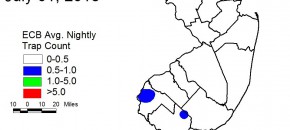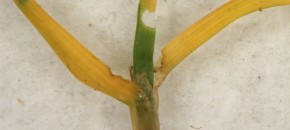As we approach the end of bloom, growers should consider the need for any post-bloom applications. The main pest targets for these applications are mainly Sparganothis fruitworm and spotted fireworm.
Continue reading...Fruit IPM Report 6-30-2015
Peach Oriental Fruit Moth (OFM): We are between 2nd and 3rd generation broods in southern counties, but still treating emerging larvae in northern counties. Growers who have trap counts that are less than 6 moths per trap can skip insecticides that are intended for OFM. If trap counts are higher, then time your sprays according […]
Continue reading...Veg IPM Update: Week Ending 7/1/15

Sweet Corn We are between European corn borer (ECB) adult generations at this time. Only scattered individuals are being captured throughout NJ (see ECB map). ECB infestations are still present in some sweet corn plantings, but whorl stage corn is now largely free of ECB injury. As always, consider treating when the number of infested […]
Continue reading...Too Much of Everything is Just Enough

Right along with stormy skies, the Plant Diagnostic Laboratory is firing up with golf turf samples. We’ve seen it all lately: anthracnose, summer patch, slime molds, take-all, Pythium root diseases, annual bluegrass weevils, black turfgrass ataenius, and lots of wear and tear. Here are a couple of random notes from the last week or two:
Continue reading...Potato | Tomato Disease Forecast 7-1-15
Click to View | Download Report 7-1-15 Potato Disease Forecasting Report We will be tracking DSVs for Late blight development and calculating P-days for initiating the first early blight fungicide application. The first late blight fungicide application is recommended once 18 DSVs accumulate from green row. Green row typically occurs around the first week in May […]
Continue reading...Wine Grape Alert: Assess Protection Against Grape Berry Moth
Grape berry moth is one of the key direct pests of grapes in NJ. Females lay their eggs on the berry and the larvae makes a small entry hole and then feeds inside the berry. Webbing may be observed as the larvae move between berries. A threshold of 10% webbing has been used in NY […]
Continue reading...